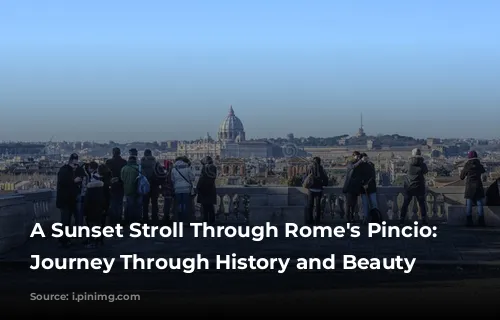Imagine the sun dipping below the horizon, casting a golden glow over Rome. From the Terrace of the Pincio, a majestic public park, the city unfolds before you, a breathtaking spectacle. Created by the renowned architect Giuseppe Valadier in 1834, this urban oasis is a beloved destination for Romans and visitors alike.
A City Unfurled: From the Pincio’s Height
As you stand on the terrace, your gaze sweeps over the sprawling cityscape. Below, the vibrant Piazza del Popolo bustles with life, resembling a grand stage. The majestic dome of St. Peter’s Basilica dominates the horizon, a testament to Rome’s enduring grandeur. To the right, Monte Mario stands tall, while the Quirinale Hill rises gracefully on the left. In the distance, high on the Janiculum Hill, you can glimpse the equestrian monument of Giuseppe Garibaldi, a symbol of Italian unification.
A Tapestry of Architectural Splendor
The scene is a harmonious blend of ancient and modern. Architectural gems from the 16th century stand out, their facades adorned with intricate details. The Pincio itself is a testament to the artistry of Valadier, who seamlessly integrated the natural beauty of the hill with the urban landscape.
A Promenade Through Time: Walking the Pincio
The Pincio invites you on a leisurely stroll, offering multiple entrances and pathways to explore its delights. You can access the promenade from Piazza del Popolo via charming ramps or from the elegant Viale di Villa Medici, which connects the terrace to the majestic Trinità dei Monti Church.
The wide promenades were initially designed for carriages, offering a glimpse into a bygone era. Today, only the Viale delle Magnolie offers a pedestrian path, allowing you to savor the tranquil beauty of the park.
The Pincio’s Perspectives: A Symphony of Art and Nature
The Pincio is a masterpiece of perspective, offering three distinct viewpoints that showcase its artistry. The first perspective (1830) features three niches, with a statue of Igea, the goddess of health, standing majestically at the center.
The second perspective is a visual feast, featuring a bas-relief depicting Fame crowning the Genes of arts and commerce. Below, a marble seat adorned with two winged lions invites you to pause and admire the scene.
The third perspective, where the Belvedere terrace rests, offers breathtaking views of the city. A covered loggia with three arches overlooks a building with three niches, each a testament to artistic genius. Here, in 1936, Raffaele De Vico created a Nymphaeum as a fountain for the Virgin Water.
Hidden Gems and Ancient Treasures
As you meander along the pathways, you’ll discover hidden gems and ancient treasures. A small oval fountain nestled near the first hairpin bend features a statue that may represent Dionysius or Hermaphrodite, a testament to the artistic and mythological richness of the past.
Further up, you’ll encounter a fountain with an ancient red granite tank dating back to the 2nd-3rd century. The water flows from a lion into a circular basin, a silent reminder of Rome’s enduring history.
Memorials and Monuments: Honoring the Past
The Pincio is also a place of remembrance. A bronze memorial dedicated to the Cairoli brothers, who died in Villa Glori in 1867, stands as a tribute to their sacrifice.
At Piazzale Napoleone I, you’ll find a breathtaking Belvedere offering panoramic views of the city. This is where the Parade of Eminent Men begins, a collection of 229 commemorative busts installed starting in 1849.
Artistic Delights: Statues, Fountains, and More
The Pincio is a treasure trove of artistic delights. A small statue of Raffaello Sanzio (1838) stands behind the Belvedere, a tribute to the great Renaissance artist.
A circular fountain on axis with the square displays a miniature Moses in the waters of the Nile (1868), a poignant reminder of the biblical story.
A Journey Through Time: Valadier’s Vision
The Pincio is a testament to the vision of Giuseppe Valadier, who transformed a humble hill into a magnificent public park. The Viale dell’Orologio (Avenue of the Clock) is a reminder of this vision, with its water clock from 1873, a masterpiece of hydraulic engineering.
The Pincio is a symphony of past and present, where history and nature intertwine to create a truly unforgettable experience. As you stroll through its paths, you’ll discover a world of beauty, art, and history that will leave a lasting impression.
